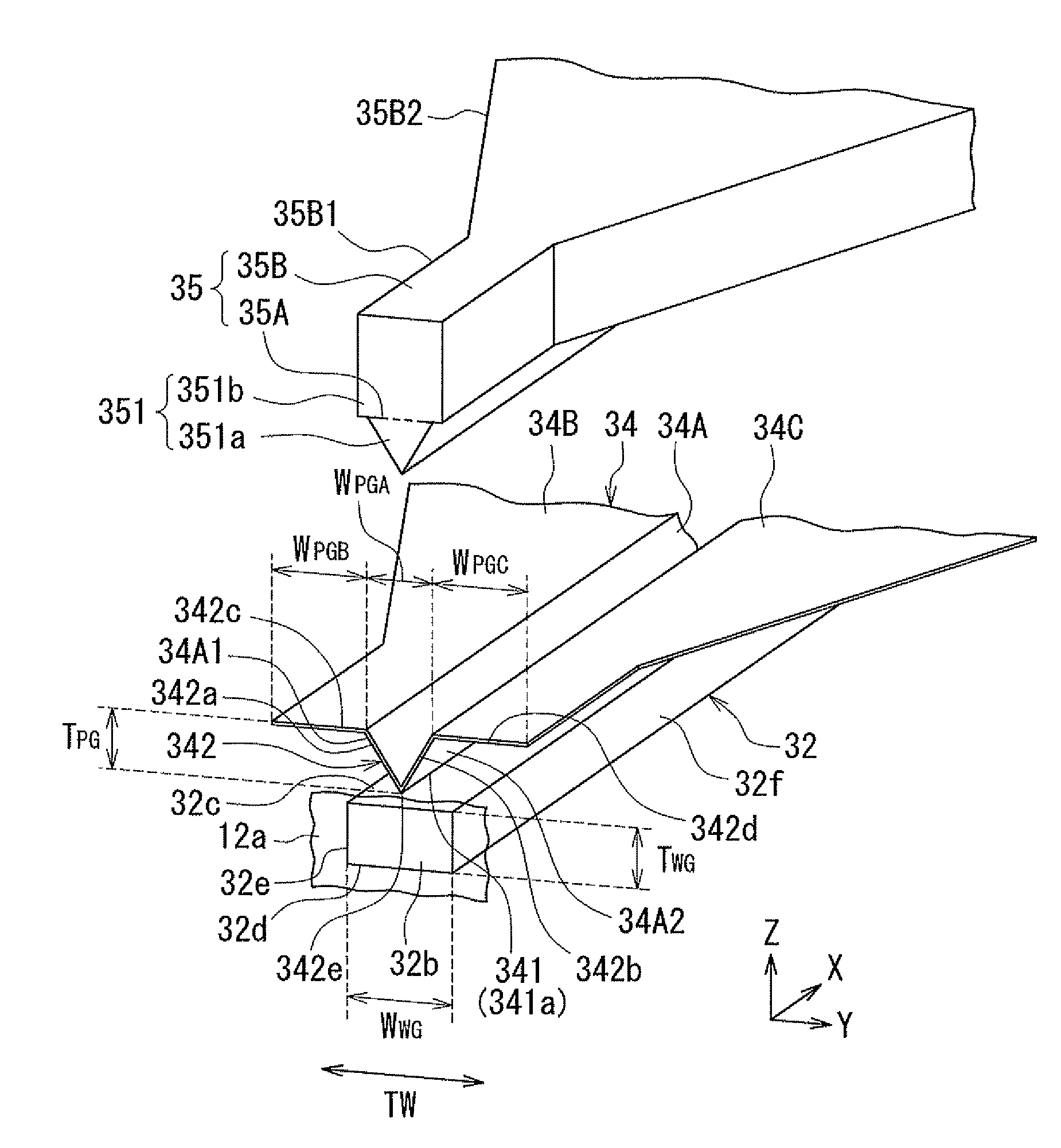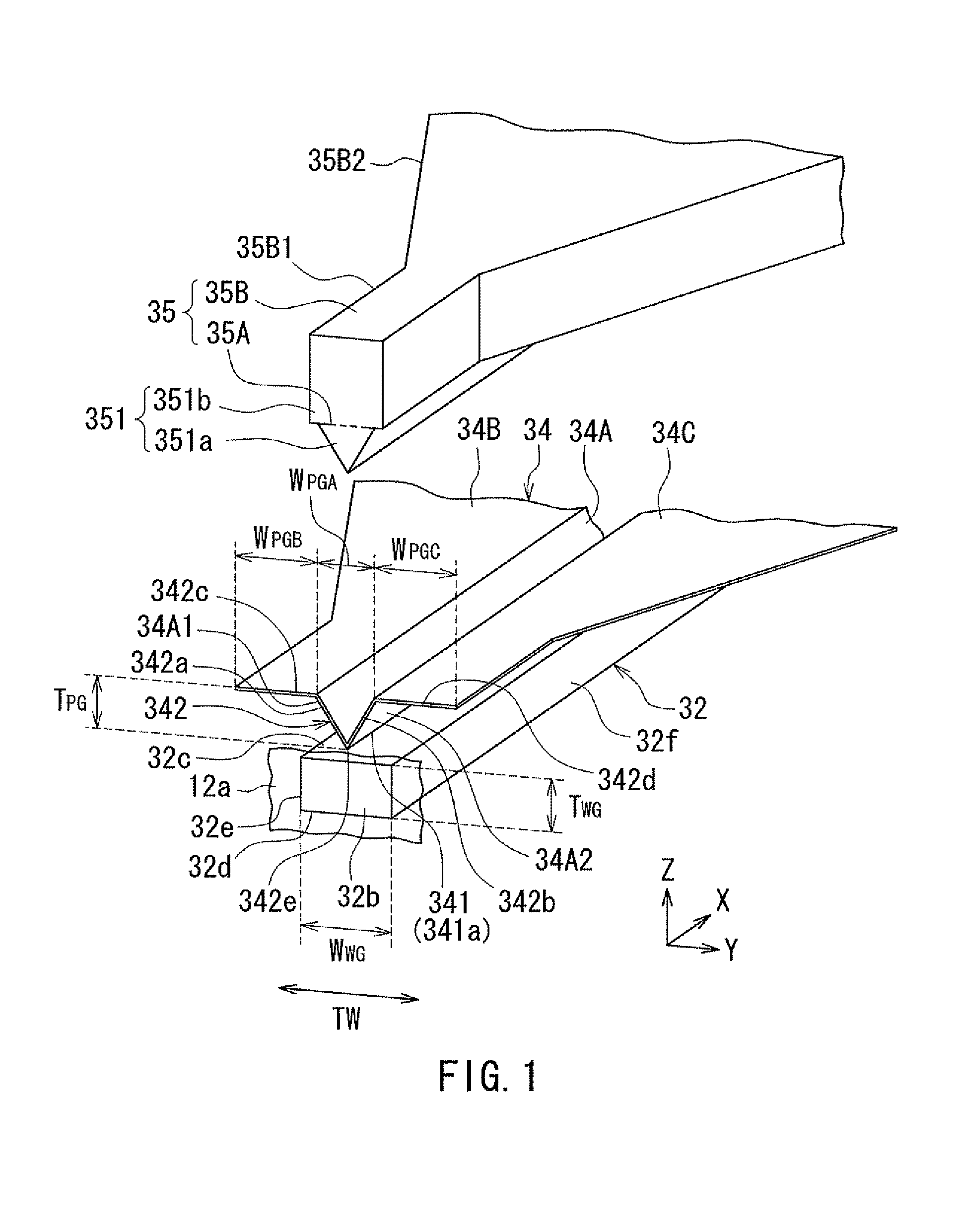Thermally-assisted magnetic recording head including plasmon generator
a technology of magnetic recording head and plasmon generator, which is applied in the field of thermally assisted magnetic recording head including, can solve the problems of increasing the coercivity of the magnetic recording medium, reducing the thermal stability of the magnetization of the magnetic fine particles, and difficult to perform data writing with existing magnetic recording heads
- Summary
- Abstract
- Description
- Claims
- Application Information
AI Technical Summary
Benefits of technology
Problems solved by technology
Method used
Image
Examples
first embodiment
[0066]Preferred embodiments of the present invention will now be described in detail with reference to the drawings. First, reference is made to FIG. 5 to describe a magnetic disk drive that functions as a magnetic recording device according to a first embodiment of the invention. As shown in FIG. 5, the magnetic disk drive includes a plurality of magnetic disks 201 as a plurality of magnetic recording media, and a spindle motor 202 for rotating the plurality of magnetic disks 201. The magnetic disks 201 of the present embodiment are for use in perpendicular magnetic recording. The magnetic disks 201 each have such a structure that a soft magnetic backing layer, a middle layer, and a magnetic recording layer (perpendicular magnetization layer) are stacked in this order on a disk substrate.
[0067]The magnetic disk drive further includes an assembly carriage device 210 having a plurality of driving arms 211, and a plurality of head gimbal assemblies 212 attached to respective distal en...
second embodiment
[0179]A second embodiment of the invention will now be described with reference to FIG. 20 and FIG. 21. FIG. 20 is a perspective view showing the core of the waveguide, the plasmon generator, and the magnetic pole of the thermally-assisted magnetic recording head according to the present embodiment. FIG. 21 is a plan view showing the plasmon exciting part of the plasmon generator shown in FIG. 20 as viewed from above. The plasmon generator 34 of the present embodiment has a first portion 34D and a second portion 34E, instead of the V-shaped portion 34A of the first embodiment. The first portion 34D has an end face located in the medium facing surface 12a. The second portion 34E is located farther from the medium facing surface 12a than is the first portion 34D, such that the second portion 34E is continuous with the first portion 34D. In FIG. 20, the border between the first portion 34D and the second portion 34E is shown by a chain double-dashed line.
[0180]The first portion 34D has...
third embodiment
[0206]A third embodiment of the invention will now be described with reference to FIG. 22 and FIG. 23. FIG. 22 is a front view showing a part of the medium facing surface of the head unit of the thermally-assisted magnetic recording head according to the present embodiment. FIG. 23 is a cross-sectional view showing the core of the waveguide, the plasmon generator, and the magnetic pole of the thermally-assisted magnetic recording head according to the present embodiment. The thermally-assisted magnetic recording head according to the present embodiment has a plasmon generator 84 and a magnetic pole 85, instead of the plasmon generator 34 and the magnetic pole 35 of the first embodiment. The plasmon generator 84 is made of the same material as that of the plasmon generator 34 of the first embodiment. The magnetic pole 85 is made of the same material as that of the magnetic pole 35 of the first embodiment.
[0207]The plasmon generator 84 has an outer surface that includes a plasmon exci...
PUM
| Property | Measurement | Unit |
|---|---|---|
| length | aaaaa | aaaaa |
| wavelength | aaaaa | aaaaa |
| emittable wavelength range | aaaaa | aaaaa |
Abstract
Description
Claims
Application Information
 Login to View More
Login to View More - R&D
- Intellectual Property
- Life Sciences
- Materials
- Tech Scout
- Unparalleled Data Quality
- Higher Quality Content
- 60% Fewer Hallucinations
Browse by: Latest US Patents, China's latest patents, Technical Efficacy Thesaurus, Application Domain, Technology Topic, Popular Technical Reports.
© 2025 PatSnap. All rights reserved.Legal|Privacy policy|Modern Slavery Act Transparency Statement|Sitemap|About US| Contact US: help@patsnap.com



